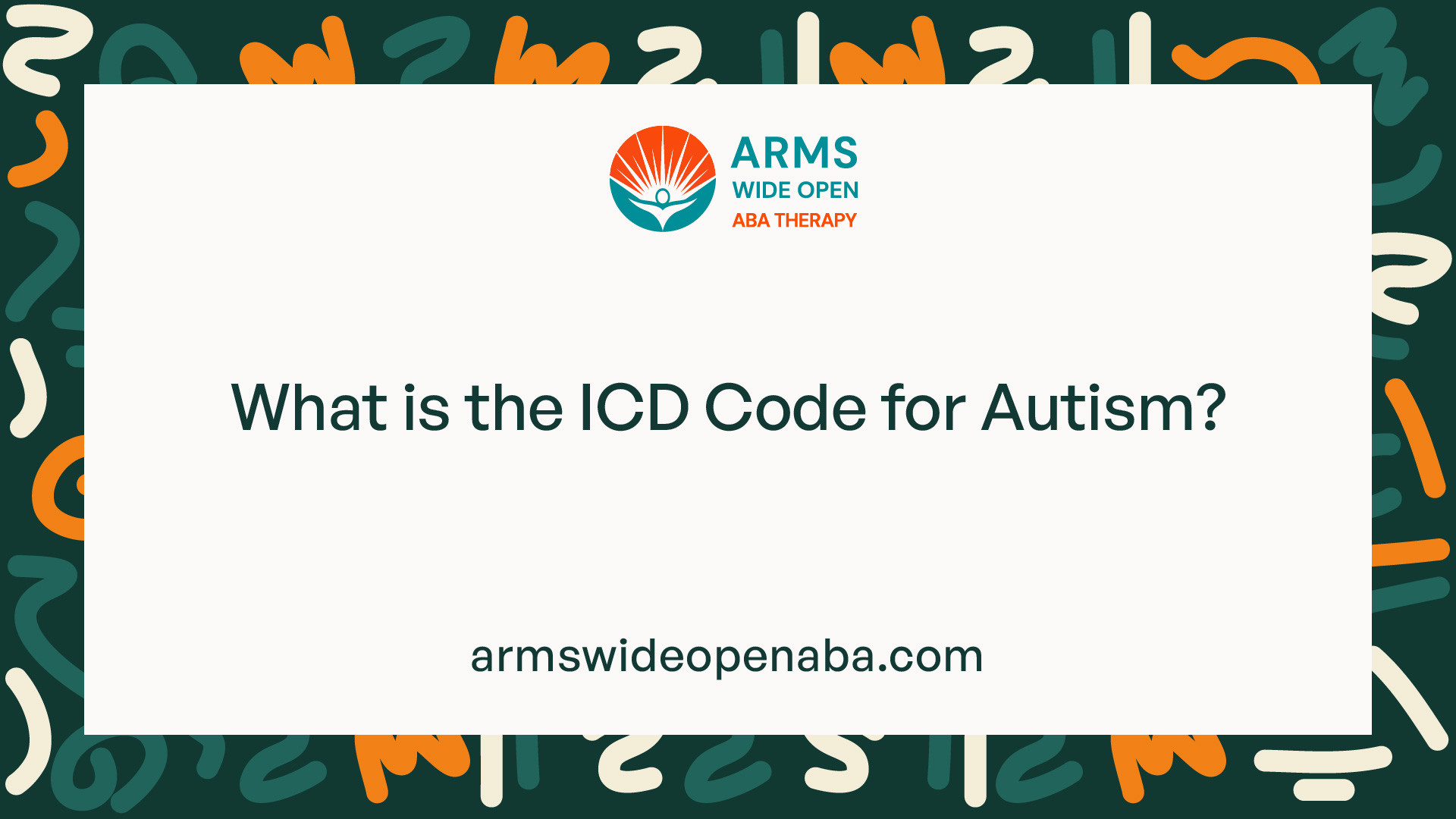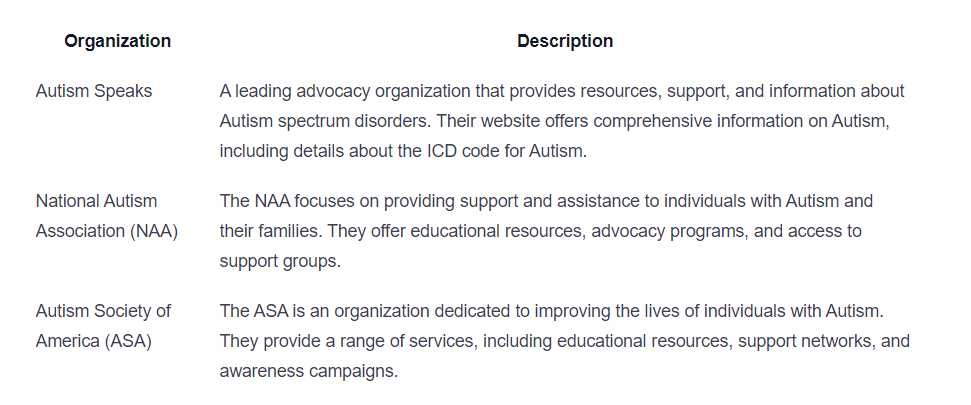What is the ICD Code for Autism?
Unlock the mystery of the ICD code for autism! Understand its importance in healthcare and navigate the system with confidence.

Understanding Autism and ICD Codes
To comprehend the relationship between autism and ICD codes, it's essential to first understand what autism is and the significance of ICD codes in the healthcare system.

What is Autism?
Autism, also known as Autism Spectrum Disorder (ASD), is a developmental disorder that affects communication, social interaction, and behavior. Individuals with autism may experience challenges in areas such as language development, social skills, sensory processing, and repetitive behaviors. Autism is a complex and diverse condition, with a wide range of symptoms and levels of impairment.
Importance of ICD Codes in Healthcare
ICD (International Classification of Diseases) codes play a crucial role in the healthcare industry. These codes are used to classify and categorize medical conditions, including autism. They provide a standardized way for healthcare providers, researchers, and insurance companies to communicate and document diagnoses.
ICD codes are used for various purposes, such as tracking disease prevalence, conducting research, guiding treatment decisions, and facilitating insurance reimbursement. By using specific codes, healthcare professionals can ensure accurate and consistent documentation of conditions, enabling better understanding, analysis, and management of various health conditions.
In the case of autism, the ICD codes help healthcare providers accurately identify and classify individuals with autism spectrum disorder. This not only aids in the diagnosis and treatment of the condition but also allows for the collection of data for research purposes. Additionally, insurance companies rely on these codes to determine coverage and reimbursement for services related to autism.
Understanding the ICD code for autism is essential for both healthcare providers and individuals seeking autism-related services. It helps streamline communication, ensure proper documentation, and facilitate access to appropriate care and support.
Introduction to ICD-10 Code for Autism
Understanding the ICD code for autism is essential for healthcare professionals, researchers, and individuals seeking information about this neurodevelopmental disorder. The International Classification of Diseases (ICD) system provides a standardized way of classifying medical conditions and assigning specific codes to facilitate accurate diagnosis, treatment, and research. In this section, we will provide an overview of the ICD-10 codes and delve into the specific ICD-10 code for autism.
Overview of ICD-10 Codes
ICD-10 is the tenth edition of the International Classification of Diseases, published by the World Health Organization (WHO). It is widely used by healthcare professionals worldwide for classifying diseases, disorders, and other health conditions. The ICD-10 codes are alphanumeric codes that represent specific diagnoses, symptoms, or procedures.
These codes play a crucial role in medical documentation, insurance claims processing, epidemiological research, and healthcare statistics. They provide a common language for healthcare professionals and facilitate accurate communication and data analysis.
Specific ICD-10 Code for Autism
Autism, also known as Autism Spectrum Disorder (ASD), has a specific code in the ICD-10 system. The ICD-10 code for autism is F84.0. This code falls under the category of "Pervasive Developmental Disorders."
The ICD-10 code F84.0 is used to specifically identify individuals with autism and is based on the diagnostic criteria outlined in diagnostic manuals such as the Diagnostic and Statistical Manual of Mental Disorders (DSM-5). It is important to note that the ICD-10 code for autism is used internationally, ensuring consistency in diagnosing and classifying autism spectrum disorders.
By utilizing the ICD-10 code F84.0, healthcare professionals can accurately document and communicate the diagnosis of autism. This code enables the collection of data for research, policy-making, and resource allocation related to autism. Additionally, insurance companies rely on these codes to determine coverage and reimbursement for autism-related services.
Understanding the ICD-10 code for autism is beneficial for healthcare providers, individuals with autism, and their families. It ensures standardized documentation, facilitates access to appropriate services, and contributes to a better understanding of the prevalence and impact of autism.
Navigating the ICD-10 Code for Autism
When it comes to understanding and using the ICD-10 code for autism, it's important to know how to locate the code and understand its components. The International Classification of Diseases, Tenth Revision (ICD-10) provides a standardized system for classifying and coding medical conditions, including autism.
How to Locate the ICD-10 Code for Autism
Locating the specific ICD-10 code for autism is a key step in accurately documenting and coding this condition. To find the code, you can refer to the ICD-10-CM (Clinical Modification) manual, which is used in the United States. The manual is organized into different sections and chapters to help navigate through various medical conditions.
To locate the ICD-10 code for autism, you would start by referring to the chapter related to Mental, Behavioral, and Neurodevelopmental Disorders. Within this chapter, you will find a section specifically dedicated to Autism Spectrum Disorder (ASD). The code for autism is found within this section, providing a specific classification for healthcare professionals to use in their documentation and coding.
Understanding the Components of the Code
The ICD-10 code for autism consists of several components that provide specific information about the condition. The code is alphanumeric and follows a structured format. Let's break down the components of the code:
- First Character: The first character of the code represents the category of the disorder. In the case of autism, the first character is "F," which corresponds to "Mental, Behavioral, and Neurodevelopmental Disorders."
- Second Character: The second character provides more specific information about the disorder. For autism, the second character is "8," which represents "Pervasive Developmental Disorders."
- Third Character: The third character offers additional details about the severity and type of the disorder. In the case of autism, the third character can range from "0" to "3," with each number indicating a different level of severity or classification.
- Fourth Character: The fourth character provides further specification regarding the type of autism or associated features. This character varies depending on the specific classification within the ICD-10-CM manual.
By understanding the components of the ICD-10 code for autism, healthcare professionals can accurately classify and document the condition in medical records. This coding system allows for consistent and standardized communication across healthcare settings, facilitating proper diagnosis, treatment, and research related to autism.
Navigating the ICD-10 code for autism is essential for healthcare providers and professionals involved in the diagnosis and management of individuals with autism. It ensures that the condition is properly identified, documented, and communicated, which can have implications for insurance coverage, reimbursement, and access to appropriate services and support.
Implications of the ICD-10 Code for Autism
Understanding the implications of the ICD-10 code for autism is essential for both diagnosis and the healthcare system as a whole. This section will explore the implications of the ICD-10 code for autism in terms of diagnosis and documentation, as well as insurance and reimbursement.
Diagnosis and Documentation
The ICD-10 code for autism plays a significant role in the diagnosis and documentation of individuals with autism spectrum disorder (ASD). It provides a standardized system for healthcare professionals to classify and record the condition, ensuring consistency and accuracy in medical records.
By using the specific ICD-10 code for autism, healthcare providers can effectively communicate and share information about an individual's diagnosis. This facilitates better coordination of care among different healthcare professionals and enables accurate tracking of the prevalence and impact of autism within the population.
In addition, the ICD-10 code for autism helps healthcare providers in identifying the appropriate treatment plans and interventions tailored to the unique needs of individuals with autism. It enables effective monitoring of progress and the evaluation of treatment outcomes, contributing to improved care and support for those on the autism spectrum.
Insurance and Reimbursement
The ICD-10 code for autism also has implications for insurance and reimbursement processes. Insurance companies and healthcare payers utilize these codes to determine coverage eligibility and reimbursement for autism-related services and treatments.
By using the specific ICD-10 code for autism, healthcare providers can accurately document and justify the medical necessity of services and interventions provided to individuals with autism. This documentation is crucial for insurance claims, ensuring that individuals receive the appropriate coverage for their healthcare needs.
Insurance companies and payers often have specific policies and guidelines regarding the coverage of autism-related services. The ICD-10 code for autism helps in aligning these policies with the standardized classification and diagnosis of the condition, ensuring that individuals with autism receive the necessary support and care they require.
It's important for individuals and their families to be aware of the insurance coverage and reimbursement policies related to autism. By understanding the implications of the ICD-10 code for autism, they can advocate for appropriate coverage and reimbursement for necessary services, therapies, and interventions.
Overall, the ICD-10 code for autism has significant implications for both diagnosis and documentation, as well as insurance and reimbursement processes. It provides a standardized classification system that promotes accurate and consistent communication among healthcare professionals and ensures appropriate coverage and support for individuals with autism.
Using the ICD-10 Code for Autism
Once the diagnosis of autism is made, the appropriate ICD-10 code is assigned to facilitate accurate documentation and communication within the healthcare system. The use of the ICD-10 code for autism is essential for healthcare providers and patients alike.
Healthcare Provider's Role
Healthcare providers play a crucial role in using the ICD-10 code for autism effectively. They are responsible for accurately documenting the diagnosis and ensuring that the appropriate code is assigned. By doing so, healthcare providers contribute to the consistency and accuracy of medical records, enabling better tracking, research, and analysis of autism cases.
When using the ICD-10 code for autism, healthcare providers should:
- Familiarize themselves with the specific code for autism (F84.0) and its associated guidelines.
- Ensure that the code is properly entered into the patient's medical records, either electronically or in paper format.
- Use the code consistently across different healthcare encounters to maintain continuity of care and accurate reporting.
- Stay updated with any changes or updates to the ICD-10 code for autism to ensure compliance with current coding standards.
By fulfilling their role in utilizing the ICD-10 code for autism accurately, healthcare providers contribute to the overall understanding and management of autism within the healthcare system.
Patient's Advocacy
As a patient or caregiver of someone with autism, understanding the ICD-10 code for autism can be empowering. It allows individuals to advocate for their rights and access appropriate support services. Here's how patients can use the ICD-10 code for autism effectively:
- Knowledge: Learn about the specific ICD-10 code for autism (F84.0) and its implications. Understand that this code represents a formal diagnosis of autism within the medical system.
- Documentation: Ensure that healthcare providers accurately document the autism diagnosis using the ICD-10 code in medical records. This ensures that the diagnosis is properly recognized and acknowledged, enabling access to appropriate resources and services.
- Insurance Coverage: The ICD-10 code for autism is crucial for insurance purposes. It helps determine eligibility for coverage of autism-related services, such as therapy, medications, and specialized interventions. Communicate the diagnosis and associated ICD-10 code to insurance providers to facilitate smooth reimbursement and access to necessary treatments.
- Advocacy: Utilize the ICD-10 code for autism when advocating for services, accommodations, and support. Sharing the code with educators, therapists, and other professionals involved in the care of individuals with autism helps them understand the specific needs associated with the diagnosis.
By actively engaging in self-advocacy and utilizing the ICD-10 code for autism, patients and caregivers can ensure that they receive the appropriate support and services they need throughout their journey.
Resources for Further Information
For individuals seeking additional information about the ICD code for Autism, there are various resources available. These resources can provide further insights into the topic and help individuals navigate the complexities surrounding Autism and its corresponding ICD code.
Additional Reading Materials
The following reading materials can provide in-depth knowledge about Autism and the associated ICD code:
- Diagnostic and Statistical Manual of Mental Disorders (DSM-5): Published by the American Psychiatric Association, the DSM-5 is a widely recognized diagnostic manual that provides criteria for the diagnosis of Autism Spectrum Disorder (ASD). It offers comprehensive information about the diagnostic process and the different subtypes of Autism.
- International Classification of Diseases, Tenth Revision (ICD-10): The ICD-10 is a global classification system for medical diagnoses, including Autism. It provides codes and guidelines for healthcare professionals to accurately document and report Autism diagnoses. The manual can be accessed online or through medical libraries.
- Research Publications: Academic journals and research papers often cover various aspects of Autism, including diagnostic criteria, treatment options, and the use of ICD codes. These publications can be found in databases like PubMed or accessed through academic institutions.
Support Organizations
Support organizations are valuable resources for individuals with Autism and their families. These organizations often provide a wealth of information, support networks, and guidance related to Autism and its associated ICD code. Some notable organizations include:

By utilizing these additional reading materials and connecting with support organizations, individuals can gain a deeper understanding of Autism and the ICD code associated with it. These resources can empower individuals to make informed decisions, advocate for themselves or their loved ones, and navigate the healthcare system more effectively.
Sources
https://on.asha.org/ldr-asd-codes
https://www.icd10data.com/ICD10CM/Codes/F01-F99/F80-F89/F84-/F84.0
https://icd.who.int/browse10/2019/en#/F84
Similar articles
We’re here to help you

Our team is here to assist you in this process. Contact us for any assistance.
it’s easy to apply
We Accept Most Insurances
Our in-network insurance partnerships make ABA therapy more accessible to families throughout our service areas.







Our Insurance Process
We'll request your insurance details to help us verify your plan's coverage for ABA therapy. Once we've received this information, we'll walk you through your benefits, including copayments, deductibles and out-of-pocket maximums, so you know what to expect in advance.
Our team will then handle the preauthorization and all the necessary paperwork.
.svg)





















.jpeg)


































.jpeg)




.jpeg)







.jpeg)











.jpeg)
















